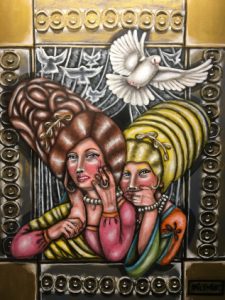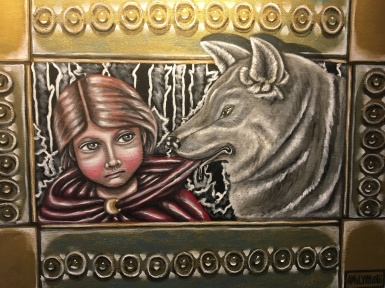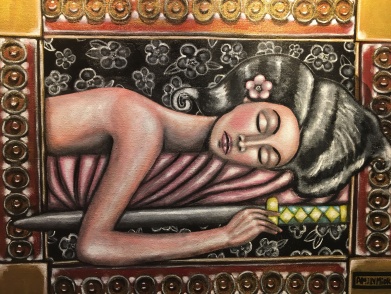calsfoundation@cals.org
Fairy Tales in a Minor Key by Painter Amily Miori
An Art Exhibition for the Whole (Addams) Family

When you walk into the gallery, the oil paintings look like the best fairy tales: colorful, layered, and slightly too vivid for comfort. The scenes should be familiar bedtime stories, but instead each painting feels unexpected and off-kilter, to such an extent that you may take a moment to figure out which story the painting interprets.
When you look a little longer, you see that these vivid characters are coming out of their frames into our world. These people won’t stay where they belong. And they don’t seem to know whether they’re living in two dimensions or three. So, like fairy tales, these paintings have an uncanny ability to get inside your head and stay with you.
The mystery and unsettling appeal of Amily Miori’s work aren’t surprising, coming from an artist who has always incorporated surrealist elements in her paintings.
Miori’s search for a universal theme
This series, exhibited as “Au Pair Don’t Care,” takes a new direction for the artist.
“I thought, what if I could do something a little more relatable, that could reach a wider audience?” Miori said. “And then I saw online some pages of very old, original fairytales, and I started to research them. And I was fascinated by all the changes in today’s tales since the original stories, which were often disturbing.”
She looked for the original illustrations, but found they were rare. “I decided I was going to paint some of those illustrations that should go with the darker, old stories,” Miori said.
Through the Looking Glass
As she adapted her work to larger canvases, she found through a happy accident that her central scenes needed more framing. And that led to one of the most interesting features of the series, the trompe l’oeil embossed frames that suggest wood or leather. These frames, which could be covers or pages, present the surface of a much deeper world that these characters inhabit, like the other side of the looking glass. And behind the characters, as in many of Miori’s previous works, there are textiles or textile-like patterns: brocade, botanical prints, curtains, or even stylized trees or brick that create the same subtle interiority. Symmetry, repetition, and layering create a space that is simultaneously flat and deep.
A storyteller based on an old family photo
The exhibition is entitled “Au Pair Don’t Care” after its putative storyteller, a character based on an old family photo of a woman who looks as if she is going to tell “a dark story,” as Miori explains it. This storyteller, described as a rebellious au pair (or nanny), is the interpreter who has created these charming but unsettling works.

A perfect introduction to the allure of an artistic vision
It takes a unique artistic gift to create a work that initially seems innocent and perhaps childlike, but contains subtleties that modulate its mood to a minor key. Though this exhibition is sophisticated and humorous enough for adults, it would also be appropriate for most children. The youngest won’t notice or understand the darker notes of the paintings, while tweens will get a kick out of discovering them. In fact, it’s hard to imagine a better exhibition to introduce young people to what it means to have an artistic vision, a particular way of seeing the world that draws others into the artist’s consciousness.
By taking these familiar stories and making them strange, Amily Miori has indeed created a spectacle with wide interest and appeal.
Amily Miori’s “Au Pair Don’t Care” opens this Friday, September 14, with a reception from 5:00 – 8:00 pm in the Galleries at Library Square.
Highly recommended for adults and children with parental guidance.






